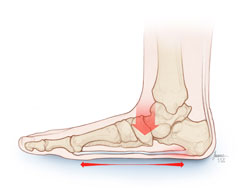A person with flat feet has no visible arch in the foot when they stand. All babies have flat feet. Arches form during early childhood. If arches don’t develop — or they collapse later in life (fallen arches) — flat feet can cause pain and affect walking. Orthotics and stretching exercises can help.

Having flat feet, also known as flatfoot, is a condition where one or both feet have little to no arch. When you stand, the pads of the feet press into the ground. Typically, you can’t see an arch in the foot, though sometimes the arch appears when you lift the foot.
All babies have flat feet at birth. Arches typically form by age 6. About two out of 10 children still have flat feet as adults. Some adults have arches that collapse. This condition, fallen arches, is another term for flatfoot.
Flat feet aren’t a problem for most people. If flat feet cause pain or other problems, treatments can help.
Cleveland Clinic is a non-profit academic medical center. Advertising on our site helps support our mission. We do not endorse non-Cleveland Clinic products or services. Policy
Flat feet can pose problems whether they persist after childhood or develop in adulthood. The types of flatfoot include:
Having flat feet may be in your genes. As a child ages, arches form in the feet. Some people have high arches, while others have very low or nearly absent arches, causing flat feet.
Some people develop flat feet later in life. The condition sometimes runs in families. And certain problems increase your risk of flat feet, including:
Many people with flat feet don’t experience pain or other problems. But certain types of flatfoot can be painful. Symptoms may include:
Your healthcare provider can make a diagnosis by assessing symptoms and evaluating how your arches look when you stand, sit and walk. You may get X-rays to look at bone structure.
Many people with flat feet don’t have significant problems or need treatment. Your healthcare provider may recommend nonsurgical treatments if you experience foot pain, stiffness or other issues. Rarely, people need surgery to fix rigid flat feet or problems with bones or tendons.
Treatments include:
Often, there isn’t anything you can do to prevent flat feet. Staying at a healthy weight may ease pain from flat feet.
Most people with flat feet get symptom relief with nonsurgical treatments. Some people don’t need any treatment. Flat feet may increase your risk of certain problems like:
You should call your healthcare provider if you experience:
You may want to ask your healthcare provider:
A note from Cleveland Clinic
Everyone has flat feet at birth. By age 6, arches typically form. Sometimes, flat feet (or fallen arches) appear during the teen or adult years. You may have pain and difficulty walking. If flat feet cause problems, see your healthcare provider. Certain nonsurgical treatments, such as stretching exercises and orthotics, can ease pain and inflammation. In rare instances, you may need surgery.
Last reviewed by a Cleveland Clinic medical professional on 05/05/2021.
Learn more about our editorial process.
Cleveland Clinic is a non-profit academic medical center. Advertising on our site helps support our mission. We do not endorse non-Cleveland Clinic products or services. Policy